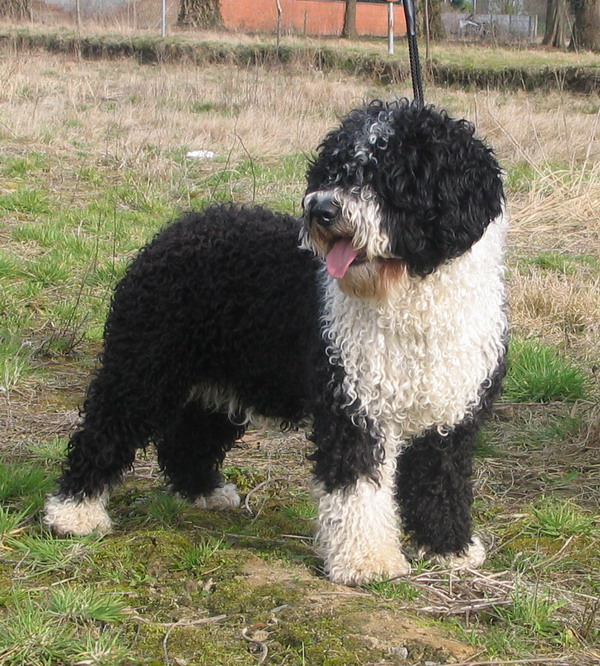The Spanish Water Dog was bred to be a jack-of-all trades and he remains that way today. His previous jobs in Spain included herding stock, assisting fishermen and possibly doing a little work as a hunting dog. As might be assumed from their name, they love the water and make excellent competitors in canine water sports. This active dog needs to be owned by people who can give them plenty of activities and exercise. Hard working and hardy, they are up for rugged hikes, intensive swimming sessions, and other outdoor activities. They will need a job in order to channel both their mental as well as their physical energy. This activity level makes them less suitable for first-time owners. When properly exercised, however, they do have an off-switch and will spend a quiet evening watching tv with the family. They are capable of living in an apartment, but only with the right owner and a whole lot of exercise!
Spanish Water Dogs have a protective side and feel a responsibility to watch over their families. They’ll never be aggressive for no reason but will stand up if danger arises or if someone breaks onto the property. In everyday circumstances, however, they are aloof to strangers while very affectionate to their owners. While many have a “whatever” attitude about meeting new people, they want to be wherever their owners are in true “velcro dog” fashion. This is a very loyal and faithful breed. Some Spanish Water Dogs enjoy the company of women over men but this is a generalization. As a sensitive breed, they do better in homes without lots of sudden sounds and movement.
The Spanish Water Dog was originally bred to work outside on the farm and didn’t start commonly living as a house dog until the 1980’s. Because of this, Spanish Water Dogs are very primitive and therefore act a little different from some other breeds. Besides being extra-sensitive in general, members of the breed can have a more intense second fear period. This period of time (usually between 9-15 months of age) is something that all dogs go through, where they are more susceptible to becoming psychologically scarred by new situations. Exposure to a scary thing while in this period can lead to a dog that has a permanent psychological damage which may then lead to them becoming excessively fearful or even a fear-biter. Socialization is the key to avoiding this – starting from the time they are very young. They need to be exposed to new things, and if they begin to show fear – to be worked through that fear.
While generally good with children, Spanish Water Dogs aren’t recommended for families with very young kids. They have a strong herding instinct and may try to herd children, which can cause unintended injury to those that are very small. Some may even take it upon themselves to discipline a running child by using a quick nip – a situation that is obviously less-than-ideal! Older kids who can handle themselves in this situation make a much better match. Their quirky temperament will definitely provide enjoyment to both children and adults alike! The Spanish Water Dog will get along with other dogs but has a definite preference for his own housemates. He may be quarrelsome with strange dogs, especially if they are pushy. 
This breed’s natural tendency to herd also makes them prone to car chasing. Not only does this mean that obedience training is necessary, but also means that all members of the family must remember to keep the front door closed. If so inclined, the Spanish Water Dog can be a master door-dasher! In the yard, a high fence is required by many breeders. This breed is quite adept at jumping, as well as climbing over fencing so containment should be regularly checked for security.
The Spanish Water Dog is very intelligent and takes well to training although he can be prone to stubbornness. Very strong-willed and occasionally manipulative, he needs consistent rules or else he will will make up his own. Some of them are naturally dominant and will try to take on the leadership position. It goes without saying that this is unhealthy for both human and dog! Keep the training fun and fair, but also firm! When done right, obedience training will awaken the dog’s natural desire to please. When done wrong, he will hold a grudge and possibly just flat-out refuse to work. A dog that is trained with excessive force might become reactive. Seek out a trainer who knows how to bring out the best in the dog. When trained, this is a very obedient and hard-working breed with a great memory.
The coat of the Spanish Water Dog is one of his key features. Naturally curly, the breed is capable of growing cords if it is allowed to grow out. Only a handful of breeds have this naturally cording coat, which will require more work upfront but less grooming when the dog gets older. In fact, brushing is not required at all for this breed! Once a year, the coat is actually sheared like a sheep. Bathing needs only be done when the coat gets dirty and the dog should be left to air dry afterward so that the cords will retain their shape. The coat is also non-shedding, which makes him a good option for those who don’t like hair tumbleweeds blowing throughout the house! This also means that he is low-dander and less likely to cause allergic reactions.
